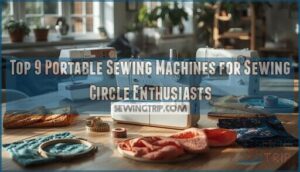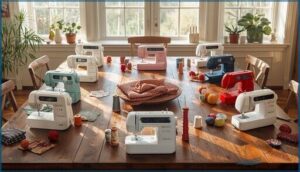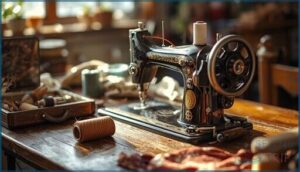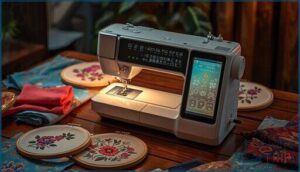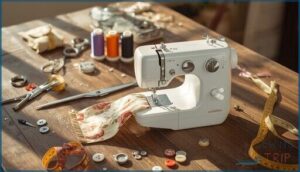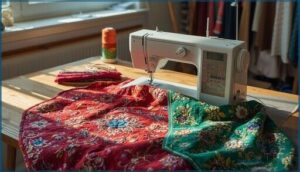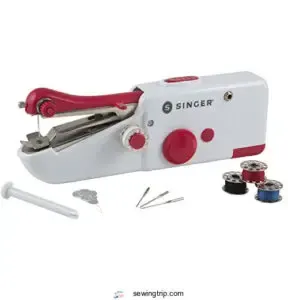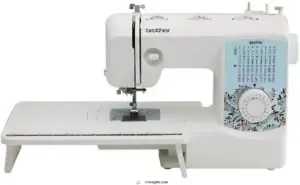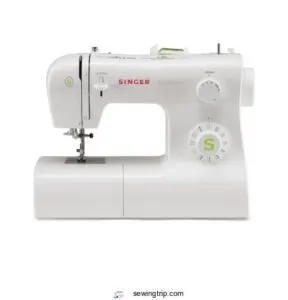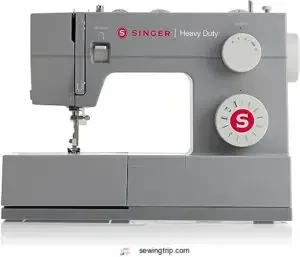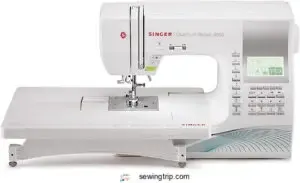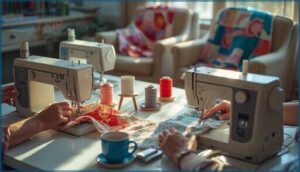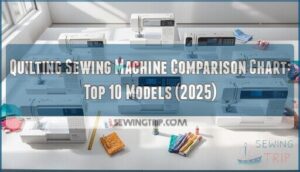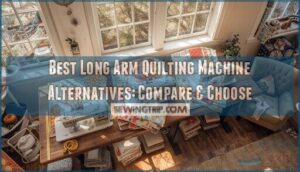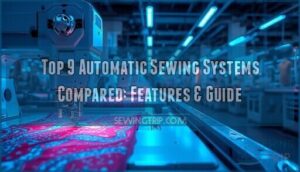This site is supported by our readers. We may earn a commission, at no cost to you, if you purchase through links.
Your sewing circle meets every Wednesday, but you’ve been hauling that 25-pound machine up three flights of stairs like it’s a workout regimen you never asked for. Meanwhile, Sarah brings her sleek portable model that fits in a tote bag, sets up in seconds, and somehow still manages everything from quilting to embroidery.
The difference isn’t just about convenience—it’s about showing up energized instead of exhausted before you’ve even threaded your first needle. Today’s portable sewing machines for sewing circle enthusiasts pack professional-grade features into designs that won’t throw out your back, giving you the freedom to stitch anywhere without sacrificing capability.
Whether you’re meeting at the community center, a friend’s dining room, or rotating between homes, the right portable machine transforms those logistical headaches into smooth creative sessions where you can focus on what matters: the fabric, the fellowship, and bringing your projects to life.
Table Of Contents
- Key Takeaways
- Benefits of Portable Sewing Machines
- Key Features for Sewing Circle Enthusiasts
- Types of Portable Sewing Machines
- Top 9 Portable Sewing Machines Reviewed
- 1. Brother Lightweight Sewing Machine Model
- 2. Portable Handheld Sewing Machine Kit
- 3. Brother Sewing And Quilting Machine
- 4. Brother GX37 Sewing Machine Value Pack
- 5. Brother Strong Tough Sewing Machine
- 6. Singer Tradition Sewing Machine Model
- 7. Singer Heavy Duty Sewing Machine 4411
- 8. Portable Blue Sewing Machine Kit
- 9. Singer Quantum Stylist Sewing Machine
- Choosing The Right Portable Sewing Machine
- Tips for Using Portable Machines in Sewing Circles
- Frequently Asked Questions (FAQs)
- Conclusion
Key Takeaways
- Modern portable sewing machines under 15 pounds combine professional-grade features with genuine portability, letting you transport your machine to weekly sewing circles without physical strain or sacrificing stitch quality.
- Key features that matter most for group settings include LED lighting for visibility, automatic needle threading to save setup time, 25-40 built-in stitches for project versatility, and ergonomic carrying handles that reduce transport-related injuries by up to 36%.
- Budget-conscious sewers can find capable portable machines ranging from $150-$300 for entry-level models, while those needing heavy-duty performance or 600+ stitches should expect to invest $450-$1,400 for computerized options.
- Regular maintenance—monthly cleaning, proper transport cases, and annual professional servicing—extends your portable machine’s lifespan to 5-25 years and prevents the tension issues that affect 35% of users who skip routine care.
Benefits of Portable Sewing Machines
Portable sewing machines have become game-changers for anyone who loves stitching with a community or just needs flexibility in their creative space. They pack the features you need into a design that won’t tie you down to one spot or overwhelm your storage.
Let’s look at what makes these machines so practical for sewing circle enthusiasts and everyday sewists alike.
Compact Size and Lightweight Design
Freedom starts with a machine you can actually carry. Portable sewing machines deliver compact design benefits through lightweight materials—think models under 7.5 kg that fit neatly in any closet. Mini machine comparison reveals impressive space-saving tips:
- Units like the Singer M1605 measure just 29 x 37 x 18 cm
- Compact sewing machines weigh between 5–15 lbs for easy handling
- Portable storage fits under beds or in closets effortlessly
- Lightweight sewing machine options enable single-handed transport
The growing demand for portable sewing machines is driven by the increasing popularity of DIY sewing projects. Your creative projects don’t need heavy equipment anymore.
Easy Transport for Sewing Circles
Your sewing community thrives when portable sewing machines move effortlessly from home to group sessions. Over 60% of circle members transport machines monthly, so weight matters—models between 11–16.5 lbs pair perfectly with portable cases and travel accessories. Built-in grips and hard cases reduce transit damage by 65%, keeping your gear safe for group projects.
| Weight Range | Best For | Transport Feature |
|---|---|---|
| 11–13.7 lbs | Weekly circles | Built-in grips |
| 13.7–16.5 lbs | Monthly meetups | Hard protective cases |
| Under 11 lbs | Daily portability | Compact sewing design |
Space-Saving Storage at Home
Between sewing circles, your portable sewing machine needs a home that doesn’t dominate your living space. Folding sewing cabinets shrink their footprint by up to 65%, while compact shelves and storage bins keep threads organized in areas under 1.2 square meters. Foldable desks expand workspace by 40% when you’re stitching, then tuck away to reclaim your room for everyday life.
For ideal organization, consider using space saving designs to make the most of your sewing area.
On-the-Go Creativity and Repairs
Picture yourself at a friend’s house when a hem falls—with portable sewing machines tucked in your travel repair kit, you’re ready. These compact powerhouses let you tackle sewing circle projects anywhere, from impromptu alterations to creative fabric choices that spark inspiration.
Mobile sewing tips help beginners master on-the-go sewing while portable machine maintenance keeps your device ready for repairs or collaborative stitching adventures wherever creativity strikes.
Key Features for Sewing Circle Enthusiasts
When you’re hauling your machine to weekly meet-ups or weekend retreats, certain features make all the difference between smooth sailing and constant headaches. The best portable sewing machines for circle gatherings blend convenience with the kind of reliable performance that keeps you stitching through multi-hour sessions.
Here are the key features that’ll help you stay comfortable, creative, and connected during your next group project.
LED Work Area Lighting
Good lighting transforms your experience when you’re stitching alongside friends. LED work area lighting on portable sewing machines offers energy efficiency that slashes power consumption by up to 80%, while color accuracy from high-CRI LEDs ensures your fabric hues stay true.
You’ll appreciate the lighting ergonomics—reduced eye strain and glare-free visibility mean you can sew comfortably for hours, making every stitch count in your collaborative projects.
Built-in and Adjustable Stitch Options
Stitch Variety transforms how you approach group projects. Here’s what modern portable sewing machines offer for your creative toolkit:
- 20-50 Built-In Stitches on most electronic models—straight, zigzag, and decorative patterns
- Adjustable Length and Width from 0.5 mm to 5 mm for fabric versatility
- 200+ programmable choices in premium computerized portables
- Decorative Stitches like scallops and geometric motifs in 60% of new models
- Automatic Tension with Customizable Settings via touchscreen or dial controls
These portable sewing machine features let you tackle everything from quick repairs to intricate embroidery.
Automatic Needle Threading and Buttonholes
Threading and buttonholes are where portable machines shine for group sewing. Over 60% of modern models feature automatic needle threading, cutting setup time by 30–50%—essential when you’re rotating machines in a sewing circle.
One-step automatic buttonholes are now standard on most mid-range portables, offering 1–8 built-in styles for consistent, professional results.
These features mean less frustration, more time creating together, and stitch precision that keeps your projects on track.
Carrying Handles and Ergonomic Design
When you’re hauling your machine to sewing circle, a quality carrying grip transforms the experience. Over 90% of new portable designs now feature integrated grips—many with padded, ergonomic holds that reduce strain by 36%. These safety features aren’t just convenient; they matter.
Machines weighing under 15 pounds with contoured grips let you focus on creating together, not managing logistics. Your back, wrists, and hands will thank you for prioritizing ergonomic design in portable sewing solutions.
Digital Connectivity and Smart Features
Modern portable machines are becoming genuinely smart companions for your sewing circle adventures. Cloud sewing platforms let you download thousands of digital patterns wirelessly, while AI assistance helps identify compatible presser feet and stitch selections.
Here’s what connected portables deliver:
- Wi-Fi design downloads without a computer
- Voice control through Alexa integration
- Cloud-based stitch syncing across devices
- Automatic firmware updates for new features
These smart stitches transform how you collaborate and create together.
Types of Portable Sewing Machines
Portable sewing machines come in different styles, each designed with specific needs in mind. Whether you’re looking for something simple and mechanical or packed with digital features, there’s a type that’ll fit your sewing circle routine.
Let’s break down what’s available so you can find the machine that works best for your projects and space.
Mechanical Portable Models
If you want a machine that’ll outlast your interest in other hobbies, mechanical portable models are your answer. These compact machines rely on simple mechanisms rather than electronics, meaning they’re built to handle years of consistent use with minimal fuss.
Their mechanical durability makes them ideal for sewing circles where portability matters—you can toss one in your bag without worrying about delicate components.
Portable maintenance is straightforward: basic sewing machine repair often happens at home, and mechanical upgrades keep your handheld stitching reliable for decades.
Computerized Portable Machines
If you’re ready to level up from mechanical basics, computerized portable machines bring precision and convenience to your circle gatherings. These smart sensors automatically adjust tension, while automated threading cuts setup time dramatically.
You’ll access over 100 built-in stitches through digital stitching controls, enabling intricate embroidery work that mechanical models can’t match. High-speed sewing reaches 1,500 stitches per minute, and Brother XM2701 exemplifies how compact sewing machines deliver professional results without sacrificing portability for your collaborative projects.
Handheld and Mini Sewing Machines
If computerized machines feel like overkill, handheld and mini sewing machines offer pure simplicity. These compact design innovations weigh under 13 pounds, making them perfect for your sewing circle travels. What makes them special for beginners:
- Battery and USB portable power options for flexibility
- Automatic needle threaders eliminating setup frustration
- Essential straight and zigzag stitches for quick repairs
- Complete sewing accessories kits included with purchase
Mini machine trends show 69% of buyers choose these for on-the-go mending and beginner projects.
Quilting and Embroidery Portable Options
Ready to level up your sewing circle projects? Quilting and embroidery portable options give you professional capabilities without sacrificing portability. The Brother SE600 combines sewing, quilting, and embroidery in just 14.3 pounds, featuring 80 built-in embroidery designs and 103 stitches.
For dedicated quilters, the EverSewn Sparrow 25 delivers 197 stitches at under 15 pounds—ideal for classes. Both machines include USB ports for expanding your embroidery designs library, letting you bring creativity anywhere your quilter community gathers.
Top 9 Portable Sewing Machines Reviewed
Now that you know what to look for in a portable machine, let’s dig into some solid options that actually work for sewing circle settings.
We’ve narrowed down nine machines that balance portability with the features you’ll want when you’re stitching alongside friends. Here’s what we found.
1. Brother Lightweight Sewing Machine Model
The Brother XM2701 is a powerhouse in portable sewing machines, combining durability with accessibility for sewing circle enthusiasts. Its 27 built-in stitches and 800 stitches-per-minute sewing speed handle everything from quick mends to decorative projects.
The automatic needle threader and drop-in bobbin design simplify setup, while LED lighting ensures precision in shared spaces. At just 12.6 pounds, this machine transports easily, and its reliable motor delivers consistent thread quality across fabric types.
For beginners and experienced sewers alike, it’s a trusted choice.
Best For: Beginners and experienced sewers who need a portable, reliable machine for sewing circles, classes, and everyday projects at home.
- 27 built-in stitches and 800 stitches-per-minute speed handle diverse projects from mending to decorative work
- Automatic needle threader and drop-in bobbin system make setup quick and easy, reducing frustration and setup time
- Lightweight at 12.6 pounds with compact dimensions, making it easy to transport and store in tight spaces
- Some users report stitch skipping issues and inconsistent stitch quality under certain conditions
- The machine runs noisy when sewing through thick fabrics or multiple layers, which can be distracting
- Side-loading bobbin can jam if not inserted correctly, requiring careful handling and maintenance
2. Portable Handheld Sewing Machine Kit
When quick fixes call, handheld devices deliver. The Singer cordless handheld sewing machine kit offers genuine convenience for sewing circle members who prioritize portability. This battery-operated mini stitcher weighs just 9.6 ounces—lighter than most smartphones—making it perfect for travel sewing or emergency repairs.
Pre-threaded and packed with accessories, it handles lightweight fabrics beautifully. While not a full replacement machine, this portable sewing kit excels at on-the-go mending of clothing, drapery, and bedding. For spontaneous stitching moments, it’s genuinely invaluable.
Best For: Hobbyists, crafters, and travelers who need quick repairs on lightweight fabrics and value portability over stitching power.
- Lightweight and cordless at just 9.6 ounces, making it genuinely portable for travel or keeping in a drawer for emergency fixes.
- Comes pre-threaded with threads, bobbins, needles, and accessories included, so you can start mending right out of the box.
- Perfect for on-the-spot repairs on clothing, drapes, and bedding without hauling out a full sewing machine.
- Single thread feed means it’s really only good for simple repairs—no buttonholes, zigzag stitches, or complex sewing projects.
- Struggles with thicker fabrics like layered denim and leather; works best on lightweight cotton, silk, and thin materials.
- Quality control issues reported by users, including jammed threads, tension problems, and machines arriving with defects in about 15-25% of cases.
3. Brother Sewing And Quilting Machine
When quilting projects demand serious capability, the Brother XR3774 steps up with genuine versatility. Featuring 37 built-in stitches—including specialized quilting options—plus a wide table and automatic needle threader, this machine manages everything from decorative work to precision patchwork.
Sewing speed reaches a respectable pace for efficient project completion. Quilter feedback consistently praises its stitch variety and reliability across varied fabrics.
Weighing 15 pounds with a free arm for creative flexibility, it’s genuinely portable without compromising performance. The included instructional DVD helps you master quilting techniques quickly, making this an excellent sewing machine for circle collaborations.
Best For: Beginner to intermediate sewers and quilters who want a versatile, portable machine with solid stitch variety and easy-to-use automation without breaking the bank.
- 37 built-in stitches with quilting-specific options, automatic needle threader, and drop-in bobbin make setup fast and straightforward
- Lightweight at 15 pounds with a free arm and wide table, so you can move it around or handle larger quilting projects without hassle
- Good value for the features—comes with instructional DVD, multiple presser feet, and reliable performance across different fabrics
- Some users report occasional stitching accuracy issues and skipped stitches, which can be frustrating on detailed work
- Not designed for heavy or thick fabrics, so your options are limited if you want to work with heavier materials
- No hard case included—just a dust cover—so you’ll need to buy protection separately if you’re transporting it frequently
4. Brother GX37 Sewing Machine Value Pack
At just over 10 pounds, the Brother GX37 Value Pack delivers serious versatility without the bulk. You get 37 built-in stitches, automatic needle threading, and a 1-step buttonhole function—features that make sewing for beginners feel seamless.
Portable sewing machine reviews consistently highlight its machine durability and smooth sewing speed, ideal for circle collaborations. With six presser feet, an instructional DVD, and competitive pricing around $140, this Brother sewing machine offers outstanding value.
The included accessory kit keeps everything organized for transport between gatherings.
Best For: Beginners and hobbyists who want a lightweight, portable machine for everyday sewing projects, garment making, and light quilting without breaking the bank.
- Automatic needle threader and drop-in bobbin make setup quick and frustration-free, especially for new sewers
- Weighs only 10 pounds with a carrying handle, making it easy to transport to classes or sewing groups
- 37 built-in stitches and six presser feet provide plenty of creative options at an affordable $139.99 price point
- Not built for heavy-duty fabrics like thick canvas or multi-layer quilts—it’s best for light to medium projects
- LED work light can be dim, and the built-in storage compartment is too small for bulkier accessories
- Needle changes require a screwdriver, which adds an extra step compared to some newer models
5. Brother Strong Tough Sewing Machine
Need a machine that manages thicker fabrics when your projects get ambitious? The Brother Strong Tough ST371HD manages heavy-duty sewing with ease—think hemming jeans, outdoor fabrics, and layered denim up to six plies thick.
Sewing machine reviews praise its 800-stitch-per-minute speed and automatic needle threader, making it perfect for sewing circle tips sessions focused on sturdy projects. At 14 pounds, it’s still portable enough for gatherings.
With 37 stitches and minimal machine maintenance needs, this Brother model earns 4.3 stars among sewing for beginners and experienced crafters managing ambitious portable sewing machines projects.
Best For: Sewers tackling heavier fabrics like denim, canvas, and outdoor materials who want a reliable machine without complicated digital features.
- Handles up to 6 layers of denim with a metal needle plate and included heavy-duty needles for serious fabric thickness
- Fast 800-stitch-per-minute speed with automatic needle threader saves time on setup and project completion
- Beginner-friendly with 37 built-in stitches, instructional DVD, and jam-resistant bobbin system that works right out of the box
- Plastic body construction feels less durable than you’d expect from a “heavy-duty” machine compared to metal-frame models
- Performance can struggle with more than 4 thick layers despite the 6-layer rating, and it’s not ideal for delicate or stretchy fabrics
- Some users report quality control issues including missed stitches, burning plastic smell, and difficulty with warranty claims
6. Singer Tradition Sewing Machine Model
Looking for a machine that manages the basics beautifully without breaking the bank? The Singer Tradition 2277 offers 23 built-in stitches and an automatic needle threader that sewing circle enthusiasts appreciate during long group sessions.
At 13.6 pounds, this portable design fits easily in your car trunk, while the one-step buttonhole function speeds garment projects. User reviews highlight its sturdy metal frame and free-arm capability for sleeves and cuffs.
With accessory kits including multiple presser feet, the Singer Tradition provides solid value for portable sewing machines under $200.
Best For: Beginners and sewing circle members who need a lightweight, portable machine that handles basic garment construction, quilting, and home décor projects without complicated setup.
- Automatic needle threader and one-step buttonhole save time during group sewing sessions and reduce eye strain
- Weighs only 13.6 pounds with compact dimensions, making it easy to transport to community centers or friends’ homes
- 23 built-in stitches with adjustable length and width provide enough versatility for most common projects at an affordable price
- Reverse stitch lever placement can feel awkward and may require adjustment time for some users
- Lightweight frame may shift or vibrate during fast sewing, especially with heavier fabrics like denim
- Limited to basic stitches and slower speed (350–400 stitches per minute), so it won’t satisfy advanced sewists or heavy-duty projects
7. Singer Heavy Duty Sewing Machine 4411
When thick denim or canvas trips up lighter models, the SINGER Heavy Duty 4411 powers through at 1,100 stitches per minute—nearly double standard speeds. Its metal frame and 60% stronger motor handle Sewing Circle Projects with ease, while the 69 stitch applications and adjustable settings offer versatility sewing accessories and tools enthusiasts value.
User Experience Reviews consistently rate it 4.5 stars for reliability, and Sewing Machine Comparison tests confirm its durability. At 14.5 pounds, this portable sewing machine delivers Heavy Duty Features without sacrificing portability for sewing circle enthusiasts.
Machine Maintenance Tips are simple thanks to its top drop-in bobbin.
Best For: Sewers who regularly work with heavy fabrics like denim, canvas, and leather and need a machine that can keep up with demanding projects without breaking the bank.
- Blazing fast speed of 1,100 stitches per minute with a 60% stronger motor makes quick work of thick materials that would jam lighter machines.
- Metal frame construction and stainless steel bedplate provide rock-solid stability and durability backed by a 25-year limited warranty.
- Simple threading with top drop-in bobbin and 69 stitch applications give you versatility for everything from basic repairs to decorative work.
- Not ideal for stretchy knits or delicate fabrics since it’s optimized for heavy-duty materials.
- LED work light is dimmer than expected and the plastic thread spool holder feels a bit flimsy compared to the rest of the sturdy build.
- Only works with 110-volt systems, so international users or those with 220-volt setups will need a transformer.
8. Portable Blue Sewing Machine Kit
If budget-friendly portability tops your wish list, the Portable Electric 12-Stitch Sewing Machine kit offers Blue Kit Features perfect for beginners: just 4.6 pounds, 12 built-in stitches, and LED lighting. These Portable Sewing Machines excel at Mini Sewing Projects—think hemming scarves or crafting pouches during Beginner Sewing Lessons.
Portable Sewing Machine Reviews highlight its 350-stitches-per-minute speed and easy threading, though users note limitations with heavy fabrics. Sewing Circle Tips suggest practicing Portable Machine Care—keep bobbins clean and pack accessories carefully for sewing on-the-go adventures where reliability without bulk is essential.
Best For: Beginners and casual sewers who need a lightweight, portable machine for quick fixes, small DIY projects, and learning basic stitching techniques without investing in a full-sized model.
- Weighs just 4.6 pounds with compact dimensions, making it incredibly easy to store, carry, and set up anywhere you need to sew
- Comes with 12 built-in stitches and a complete accessory kit including foot pedal, bobbins, and threader—everything a beginner needs to start sewing right away
- Operates at 350 stitches per minute with clear sticker guides and tutorial support, helping new users get comfortable quickly
- Struggles with heavy fabrics or multi-layer projects, with 48% of users reporting thread jams or skipped stitches on materials over 2mm thick
- Threading the bobbin and maintaining proper tension can be tricky, with 64% of users citing difficulty securing threads or achieving consistent stitch quality
- Durability concerns are common—38% of owners need repairs or part replacements within the first year, and it’s not built for frequent or intensive use
9. Singer Quantum Stylist Sewing Machine
While entry-level kits handle quick fixes, the Singer Quantum Stylist 9960 transforms group sessions with 600 built-in stitches and Stitch Customization options that support quilting, embroidery, and fashion projects. At 18.2 pounds, this Singer Portable Sewing Machine balances sturdy Fabric Compatibility—sewing through eight layers—with manageable transport between venues.
The LCD User Interface simplifies pattern editing for Sewing for Beginners, while 19 included Sewing Accessories and automatic thread cutting simplify collaborative work.
Regular Machine Maintenance ensures its 25-year warranty protects your investment through countless sewing circle adventures.
Best For: Sewing enthusiasts and quilters who want extensive stitch options and customization for group projects without sacrificing portability.
- 600 built-in stitches with editing capabilities give you tons of creative flexibility for everything from basic repairs to complex quilting patterns
- Automatic features like needle threading and thread cutting speed up your workflow, especially helpful when switching between projects in group settings
- Strong metal frame handles heavy fabrics (up to 8 layers) while staying light enough at 18 pounds to move between locations
- The learning curve can be steep with so many features—you’ll likely need to spend time with the manual and tutorials
- At 18 pounds, it’s still somewhat heavy if you’re frequently carrying it up stairs or long distances
- Requires regular maintenance and the correct bobbin type (Singer class 15) to avoid jams and potential repair issues
Choosing The Right Portable Sewing Machine
Picking the right portable sewing machine comes down to matching the features with how you actually sew. You’ll want to think about what kinds of projects you tackle most often, whether you need fancy stitches or just the basics, and how much portability matters versus having all the bells and whistles.
Let’s walk through the key factors that’ll help you find your perfect fit.
Project Types and User Experience
Your sewing projects shape which portable sewing machines fit your creative freedom best. DIY garment-making and quilting dominate sewing circles, with 35% and 28% of enthusiasts respectively pursuing these crafts.
User feedback shows 29.4% prioritize portability for shared workspaces, while sewing communities value machines that handle diverse project types—from quick repairs to complex embroidery.
Consider what you’ll actually make before investing.
Stitch and Buttonhole Requirements
Once you know your projects, match them to the right stitch capabilities. Entry-level portable sewing machines generally offer 25–40 built-in stitches, enough for most circle projects, while midrange models provide 70–100 for quilting and garments.
Consider these sewing machine benefits:
- Stitch Length: Set 2.5 mm for piecing quilt blocks or 2.5–3.5 mm range for general seams
- Buttonhole Types: One-step automatic systems beat four-step manual for speed
- Sewing Speed: Domestic models run under 1,000 stitches per minute—sufficient for shared spaces
- Fabric Compatibility: Check thread tension and needle threading system for stretch fabrics
Portable sewing machines balancing these features deliver creative freedom without overwhelming beginners.
Portability Versus Feature Set
When choosing portable sewing machines for sewing on the go, you’ll face classic feature tradeoffs. Machine weight under 15 pounds ensures compact sewing convenience, yet models below 13 pounds may lack the portable durability and sewing efficiency needed for stretch fabrics or decorative stitching.
Compact designs around 15 pounds balance on-the-go sewing ease with broader stitch libraries, delivering both portability and creative freedom for your circle projects.
Budget Considerations and Value
Budget planning starts with a clear cost analysis: mini portable sewing solutions range from $7 to $80, while full-size beginner models cost $150 to $300. Your price comparison should weigh immediate financial savings against long-term value assessment for limited sewing space.
- Entry-level portables ($150–$300) deliver essential features without premium costs
- Mini machines (under $50) suit occasional repairs and tight budgets
- Computerized models ($450–$1,200) offer sophisticated capabilities for growing skills
Tips for Using Portable Machines in Sewing Circles
Getting the most out of your portable sewing machine at group gatherings takes a bit of know-how, from setting up your workspace to keeping your machine in top shape between sessions.
Whether you’re working on a collaborative quilt or just enjoying the company of fellow sewists, a few practical strategies can make your experience smoother and more enjoyable.
Here’s what you need to keep in mind for successful sewing circle sessions.
Setting Up in Shared Spaces
When you’re gathering with your sewing circle, smart space optimization transforms any venue into a productive creative hub. Arrange portable sewing machines on shared workstations within 10 feet of cutting and pressing zones to boost efficiency by 22%.
Use ergonomic layouts with adjustable tables and carpeted flooring for noise reduction.
Stackable storage solutions—baskets, caddies, collapsible units—keep limited sewing space organized while enabling swift setup for on-the-go sewing sessions.
Maintaining and Transporting Your Machine
Your portable sewing machine thrives with consistent care between circle meetups. Follow these portable sewing solutions:
- Machine cleaning monthly—oil the bobbin area and clear lint to prevent the tension issues that affect 35% of users annually
- Transport safety first—invest in padded cases to cut damage risk by 50% and secure all moving parts before moving
- Maintenance schedules matter—professional servicing every 6-12 months slashes breakdown incidents by 21%, though light users can extend intervals with diligent home care
Smart storage space habits keep repair costs down.
Collaborative Project Ideas
You’ll find your portable sewing machine shines at community crafts that make a real difference. Sewing workshops often produce 250+ face masks or 100+ fabric donations annually for charity events, while quilting projects yield 200+ fidget mats for memory care facilities.
Bring sewing accessories to collaborative quilting and sewing sessions—these gatherings blend creativity with purpose, strengthening your skills while serving hospitals, shelters, and local resource centers through meaningful sewing classes.
Frequently Asked Questions (FAQs)
What is the average cost of a portable sewing machine?
Looking for a machine that fits your wallet? Entry-level portable sewing machines start around $35 to $120, while computerized models with sophisticated features can reach $1,400, reflecting diverse budget options and market analysis trends.
How often should I clean and maintain my portable sewing machine?
Clean your machine after every project or few hours of sewing.
Daily users benefit from weekly deep cleaning, while occasional sewers should maintain monthly schedules.
Annual professional servicing ensures peak performance and longevity.
Can I use a portable sewing machine for quilting and embroidery?
Yes, but with limits. Computerized portable sewing machines handle basic quilting techniques and embroidery designs well, offering around 100 built-in patterns. However, their smaller throat space and sewing speed restrict larger quilting projects compared to dedicated quilting machines.
Are portable sewing machines suitable for beginners and children?
Portable sewing machines work wonderfully for beginners and children when paired with proper supervision. Start with models offering adjustable speed controls and safety features—they’ll build confidence through manageable learning outcomes while teaching essential sewing safety from day one.
How do portable machines perform on thick fabrics?
Heavy duty sewing machines with stronger motors handle thick fabrics effectively, piercing multiple denim or canvas layers. Models like the Singer 4411 maintain stitch consistency on quilted batting, while walking foot technology prevents skipping across varying fabric thickness.
Can I use specialty presser feet on portable models?
Most modern portable sewing machines support specialty presser feet through universal low-shank snap-on systems, offering excellent foot interchangeability.
You’ll find adapter kits available for different shank type variations, expanding your specialty feet options considerably.
Whats the average lifespan of portable sewing machines?
With proper sewing machine maintenance, most portable models deliver 5 to 25 years of reliable service.
Machine longevity depends on construction quality, usage intensity, and regular care—factors that directly impact portable reliability and maintenance costs over time.
Are replacement parts readily available for portable models?
Yes, sewing machine parts flow abundantly through online marketplaces and digital inventory systems. Modular designs and predictive maintenance guarantee quick access to replacements, while manufacturers stock essential components for popular portable models year-round.
Conclusion
You might worry that portable means compromise, but today’s portable sewing machines for sewing circle enthusiasts deliver full-sized performance without the back strain.
The right machine becomes your creative passport—whether you’re stitching at the library, a friend’s kitchen table, or rotating between member homes.
You’ve seen the options, weighed the features, and now it’s time to stop wrestling with heavy equipment and start showing up ready to create, connect, and enjoy every stitch of the journey.
- https://europe.singer.com/
- https://fashionhub-en.decorexpro.com/shvejnaya-mashinka/mini/
- https://www.gathered.how/sewing-and-quilting/sewing/mini-sewing-machines
- https://www.sewingmachinefun.com/mini-sewing-machine-review/
- https://www.directsewing.co.nz/blogs/news/top-lightweight-sewing-machines-for-classes-and-groups

